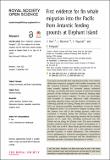Files in this item
First evidence for fin whale migration into the Pacific from Antarctic feeding grounds at Elephant Island
Item metadata
| dc.contributor.author | Herr, H. | |
| dc.contributor.author | Hickmott, L. | |
| dc.contributor.author | Viquerat, S. | |
| dc.contributor.author | Panigada, S. | |
| dc.date.accessioned | 2022-09-30T11:30:05Z | |
| dc.date.available | 2022-09-30T11:30:05Z | |
| dc.date.issued | 2022-09-30 | |
| dc.identifier | 281539412 | |
| dc.identifier | f522cc9f-09c6-45ce-a9ef-960d2a457501 | |
| dc.identifier | 000858613000003 | |
| dc.identifier | 85139639348 | |
| dc.identifier.citation | Herr , H , Hickmott , L , Viquerat , S & Panigada , S 2022 , ' First evidence for fin whale migration into the Pacific from Antarctic feeding grounds at Elephant Island ' , Royal Society Open Science , vol. 9 , no. 9 , 220721 . https://doi.org/10.1098/rsos.220721 | en |
| dc.identifier.issn | 2054-5703 | |
| dc.identifier.other | Jisc: 614452 | |
| dc.identifier.other | publisher-id: rsos220721 | |
| dc.identifier.uri | https://hdl.handle.net/10023/26110 | |
| dc.description | Funding: This work was funded by IWC-SORP and by the DFG within the priority programme SPP 1158 ‘Antarctic Research with comparative investigations in Arctic ice areas’ by grant HE5696/3-1. Additional funding from National Geographic / Disney+ supported field efforts by Hickmott. | en |
| dc.description.abstract | This study presents the first long-distance tracks of fin whales (Balaenoptera physalus) equipped with satellite transmitters off the Antarctic Peninsula. Southern Hemisphere fin whales were severely depleted by twentieth century industrial whaling, yet recently, they have returned to historical feeding grounds off the northern Antarctic Peninsula, forming large aggregations in austral summers. To date, our knowledge only extended to summer behaviour, while information regarding migration routes and the location of breeding and wintering grounds are lacking. During the austral autumn of 2021, we deployed nsatellite transmitters on four fin whales at Elephant Island. Two transmitters stopped working while the animals were still at the feeding grounds, while two continued to transmit during the transition from feeding activity to migration. Both migrating animals left the feeding ground on 15 April 2021, travelling northward into the Pacific and up along the Chilean coast. The most northerly position received before all tags stopped transmitting on 1 May 2021 was at 48°S. These tracks provide initial evidence of seasonal migratory routes and a first indication toward possible locations of winter destinations. This information, even if preliminary, is critical for investigations of population connectivity, population structure and the identification of breeding grounds of Southern Hemisphere fin whales. | |
| dc.format.extent | 8 | |
| dc.format.extent | 841039 | |
| dc.language.iso | eng | |
| dc.relation.ispartof | Royal Society Open Science | en |
| dc.subject | Ecology, conservation and global change biology | en |
| dc.subject | Research articles | en |
| dc.subject | Satellite telemetry | en |
| dc.subject | Southern Ocean | en |
| dc.subject | Balaenoptera physalus | en |
| dc.subject | Population connectivity | en |
| dc.subject | Migratory route | en |
| dc.subject | GC Oceanography | en |
| dc.subject | QH301 Biology | en |
| dc.subject | DAS | en |
| dc.subject | MCC | en |
| dc.subject.lcc | GC | en |
| dc.subject.lcc | QH301 | en |
| dc.title | First evidence for fin whale migration into the Pacific from Antarctic feeding grounds at Elephant Island | en |
| dc.type | Journal article | en |
| dc.contributor.institution | University of St Andrews. Arctic Research Centre | en |
| dc.contributor.institution | University of St Andrews. School of Biology | en |
| dc.contributor.institution | University of St Andrews. Sea Mammal Research Unit | en |
| dc.identifier.doi | 10.1098/rsos.220721 | |
| dc.description.status | Peer reviewed | en |
This item appears in the following Collection(s)
Items in the St Andrews Research Repository are protected by copyright, with all rights reserved, unless otherwise indicated.

